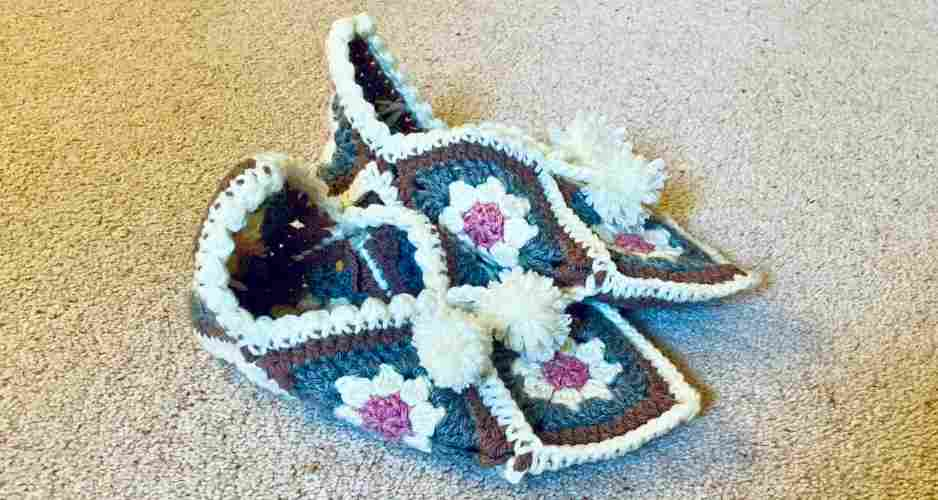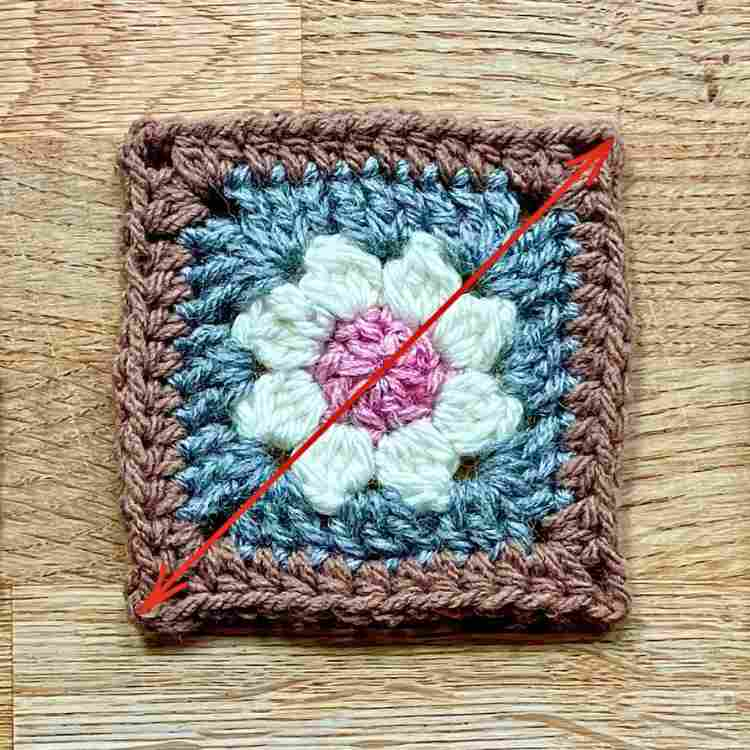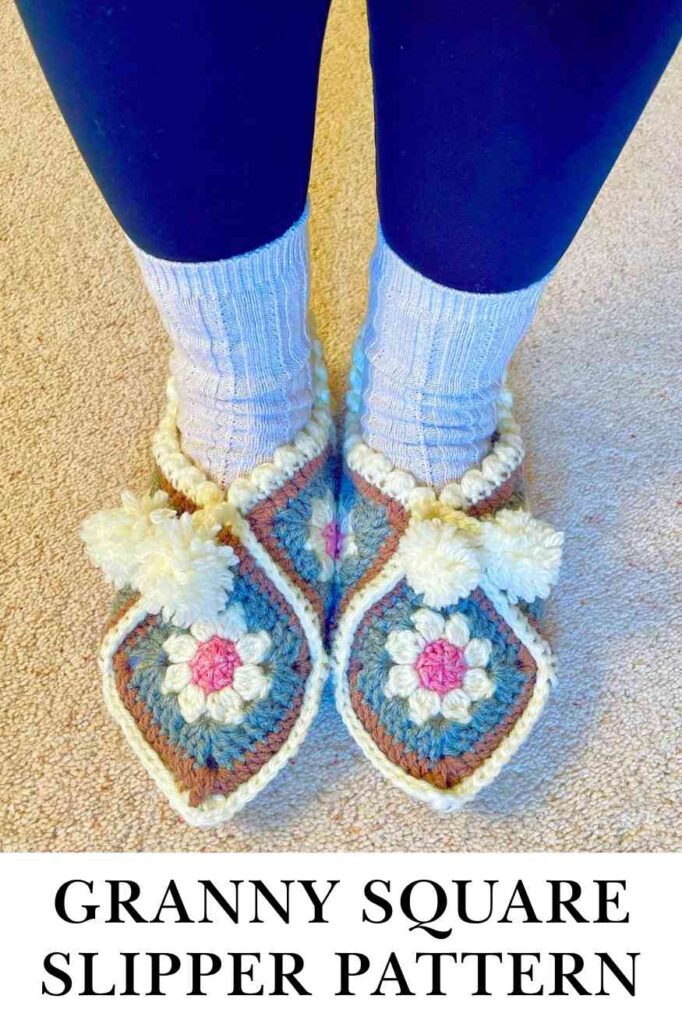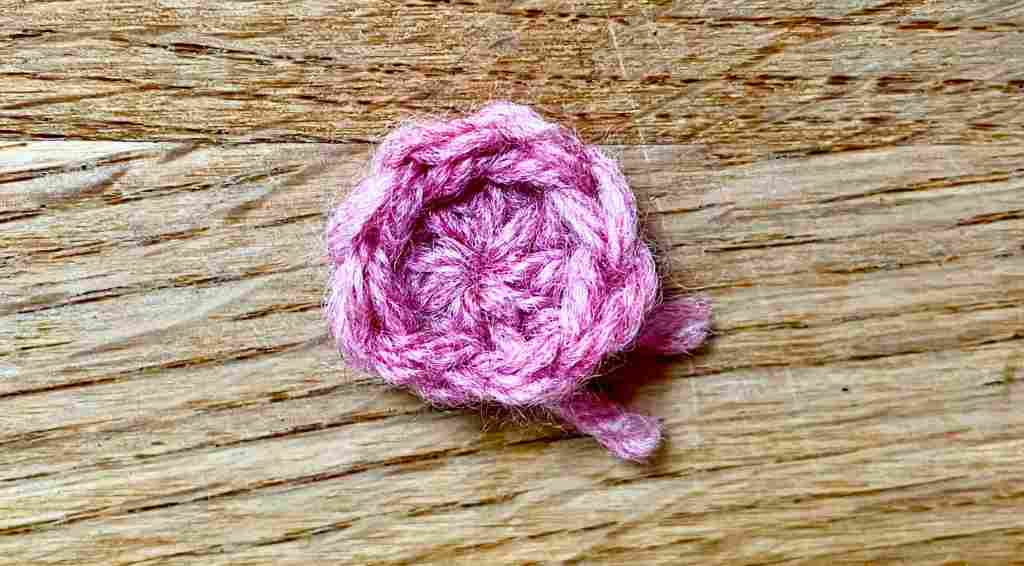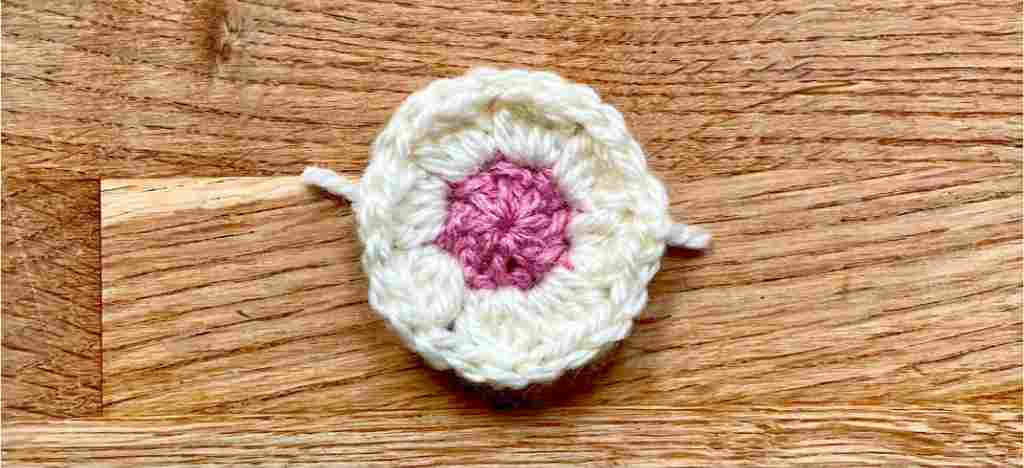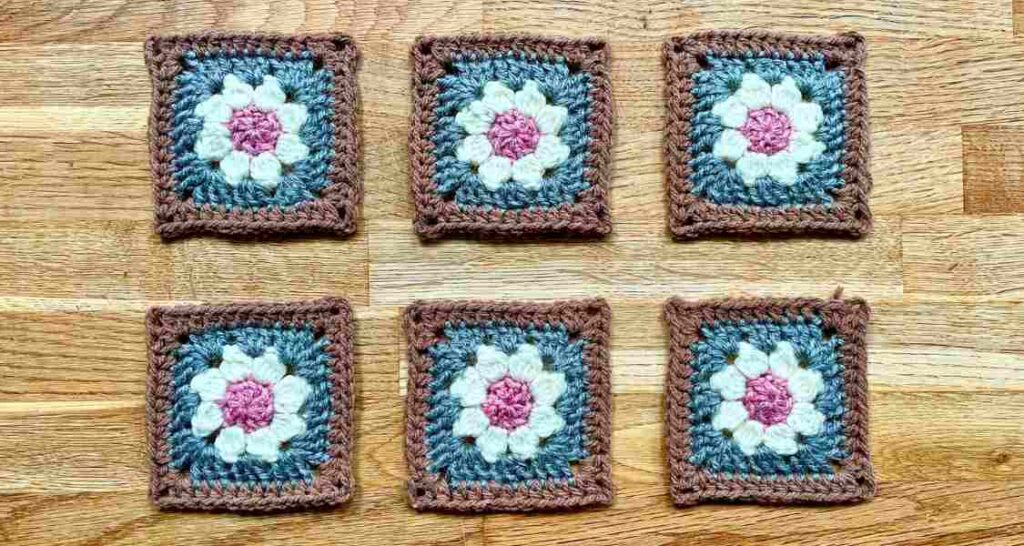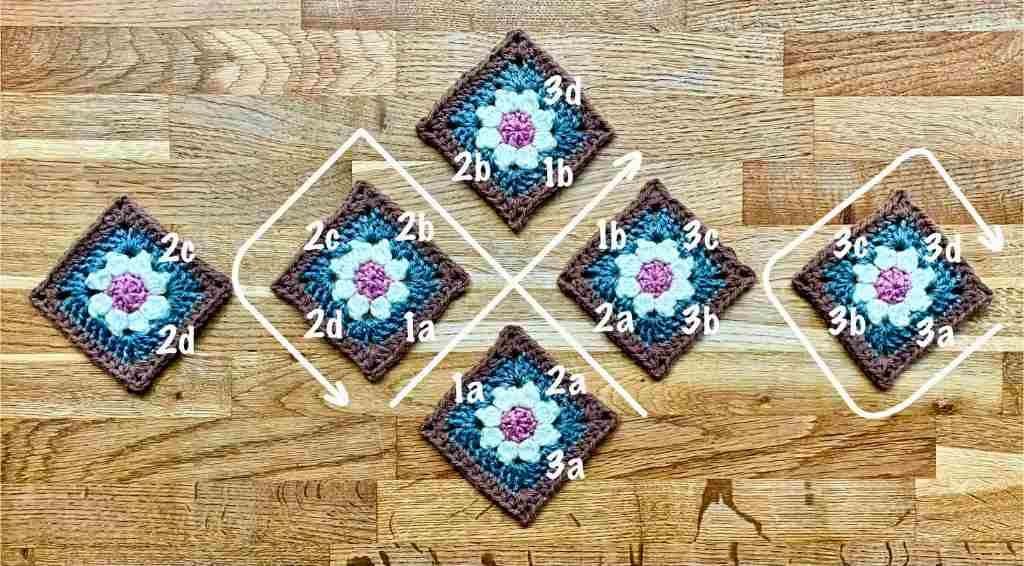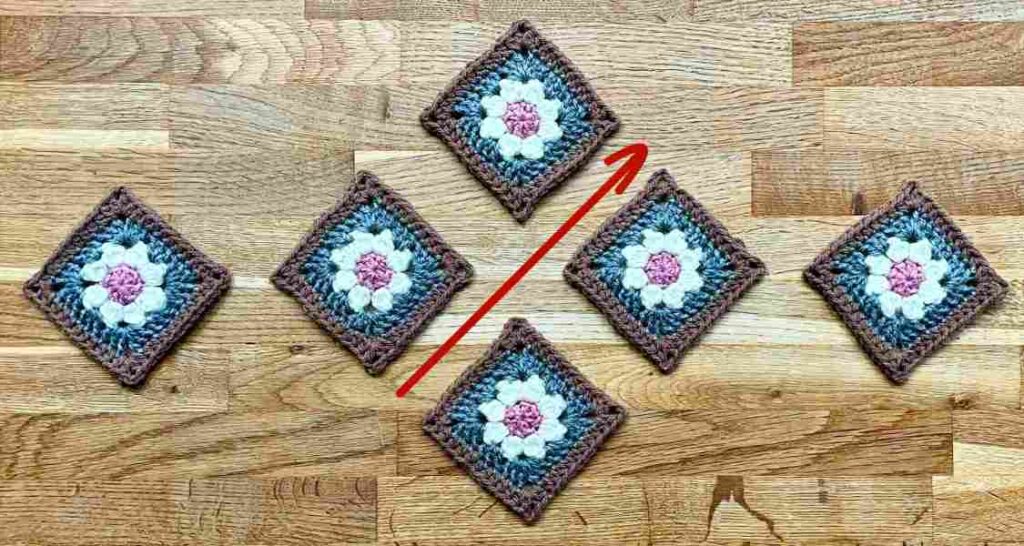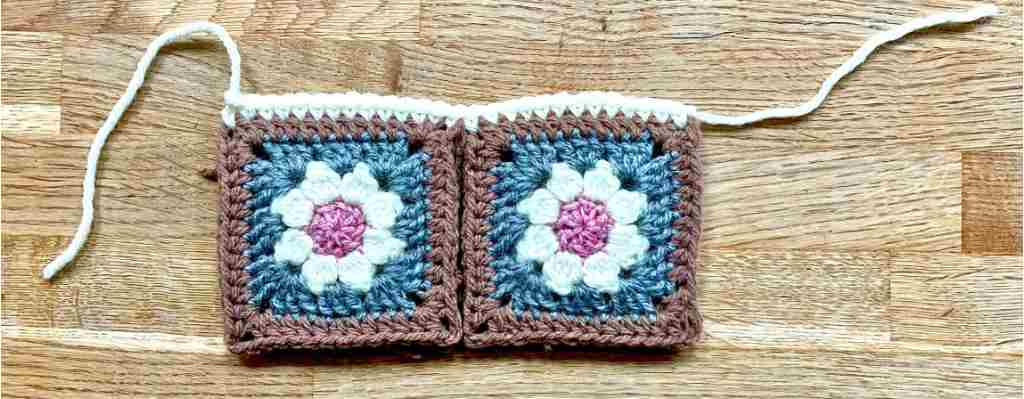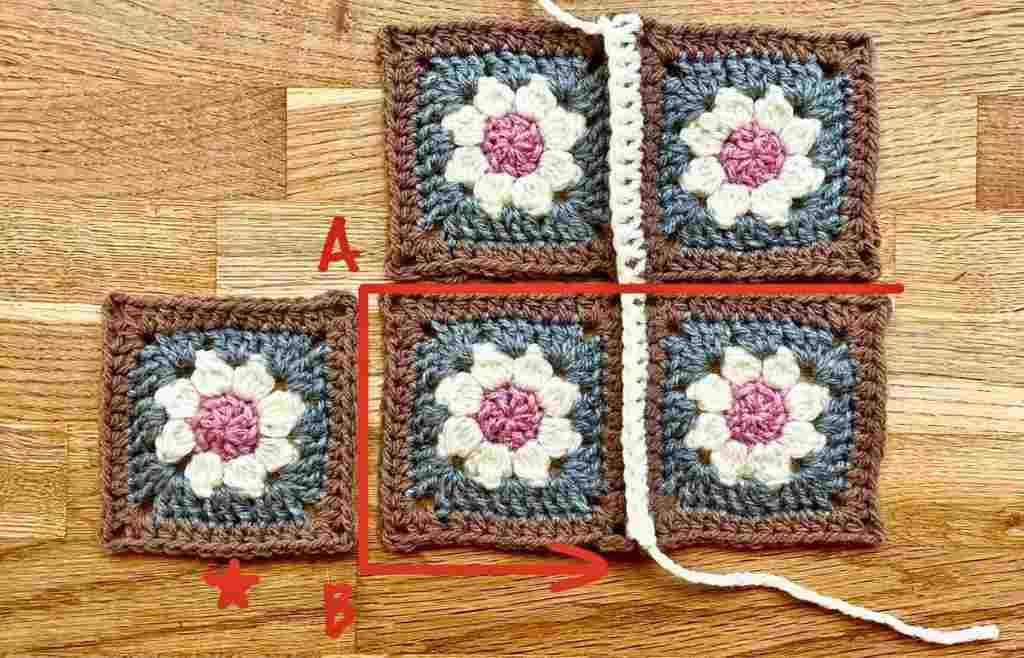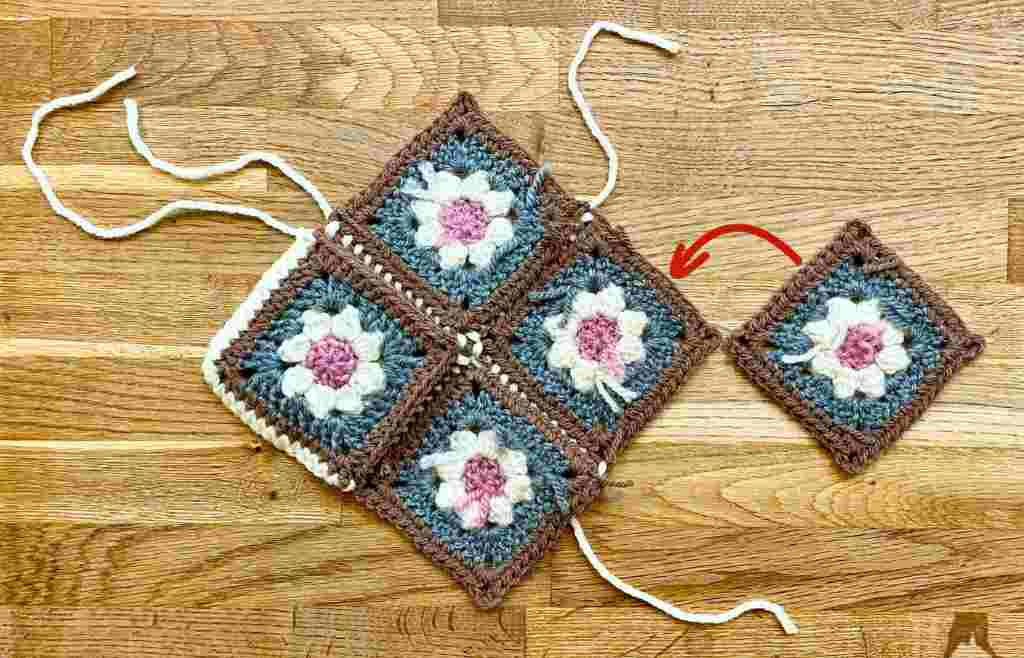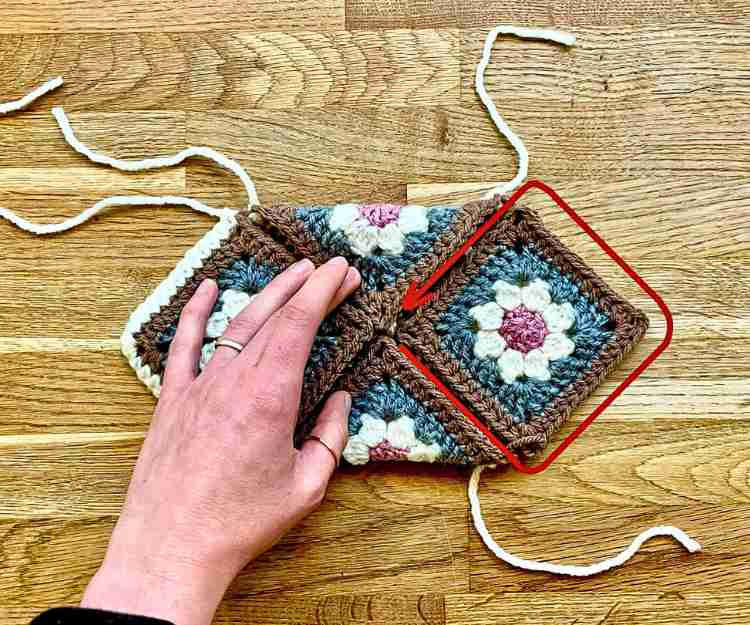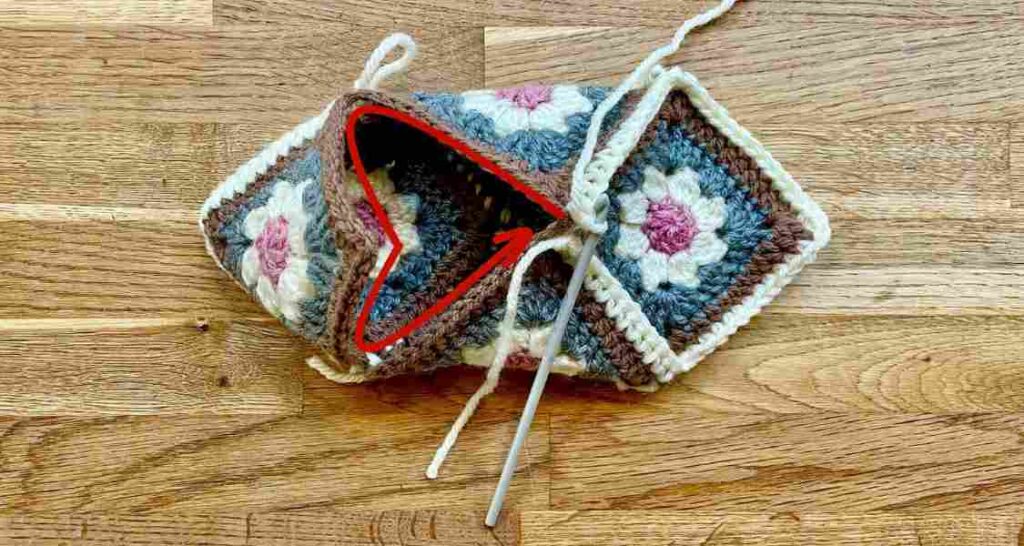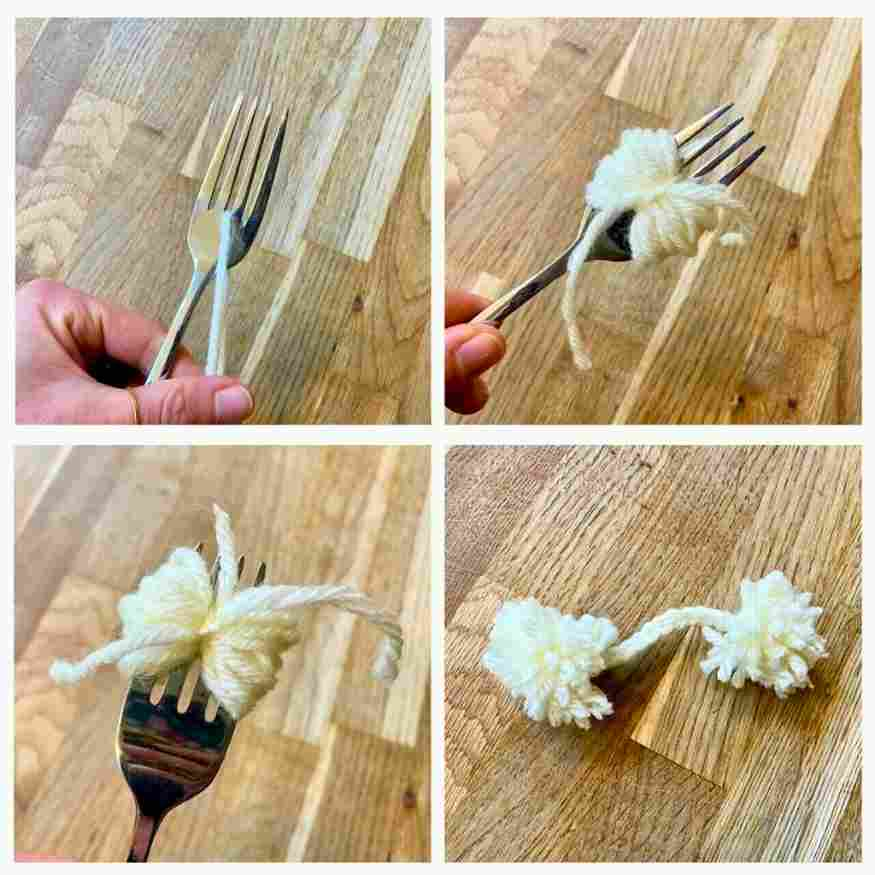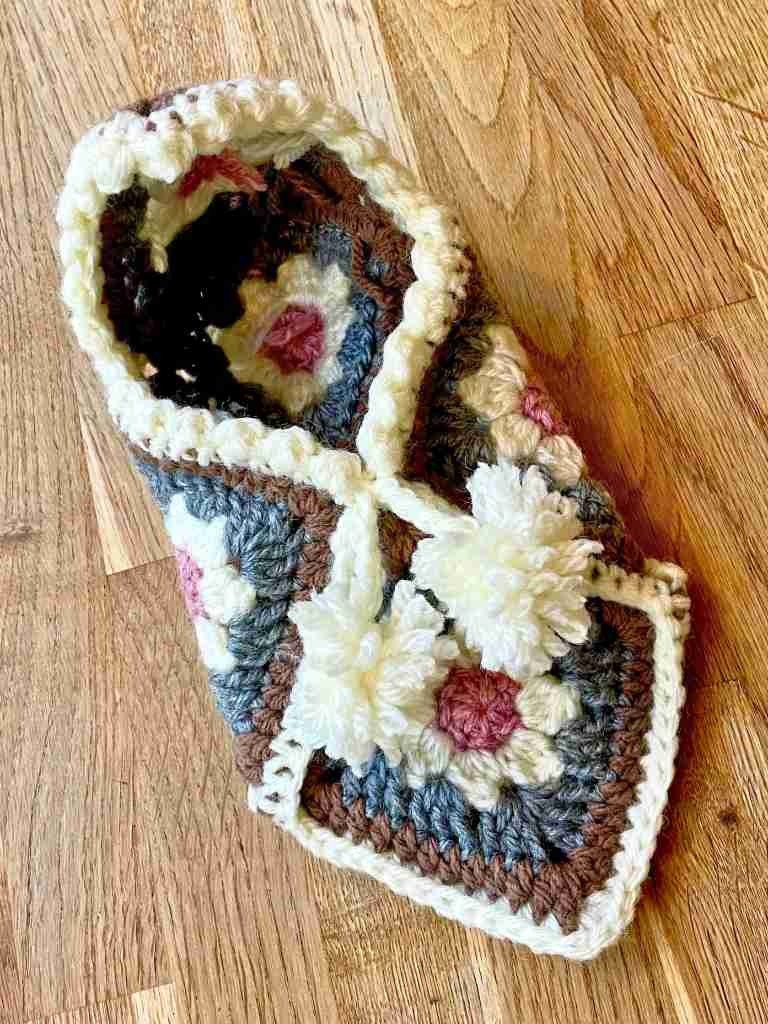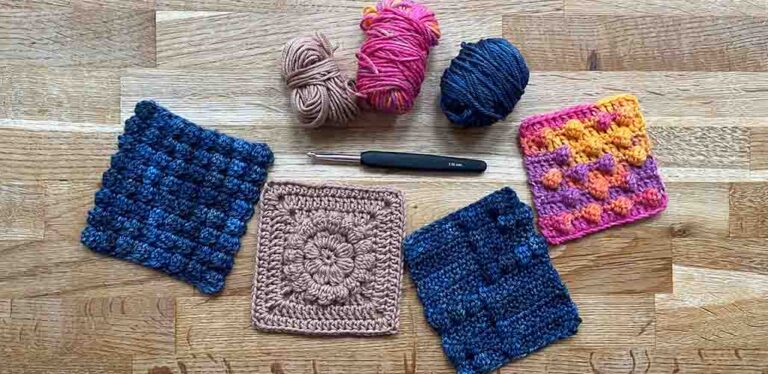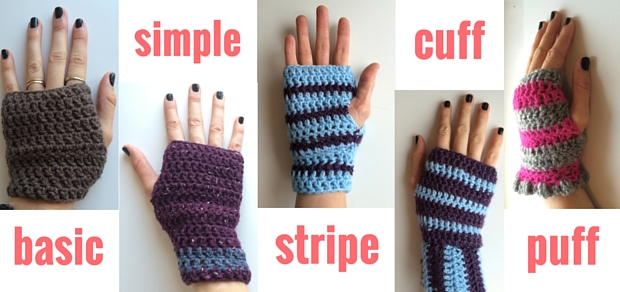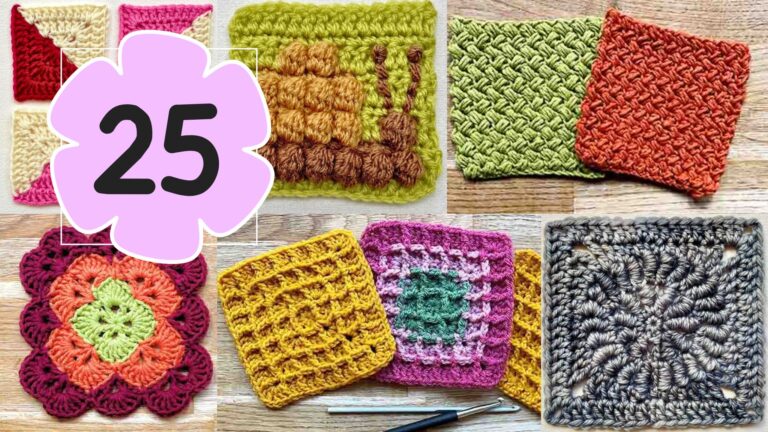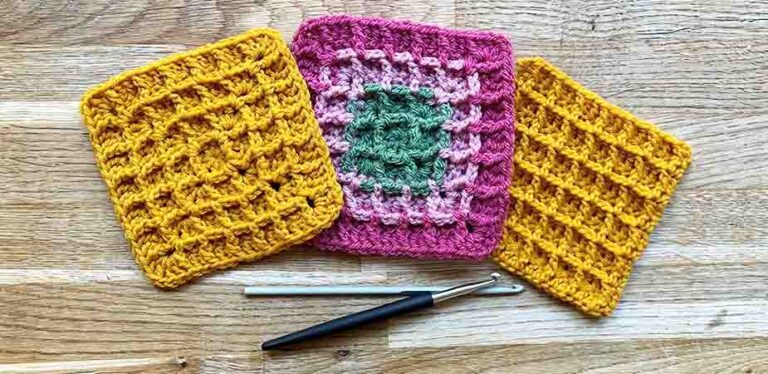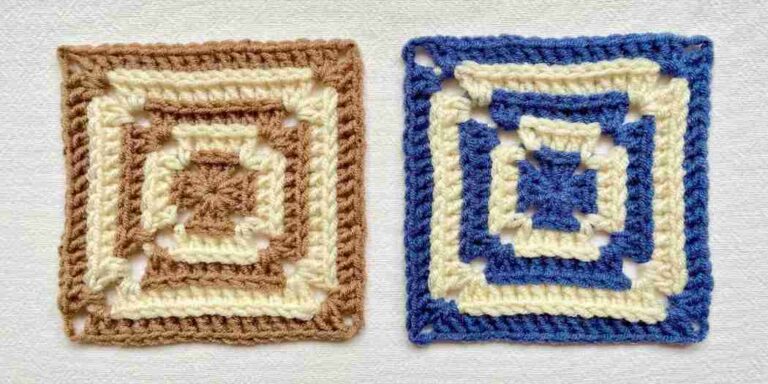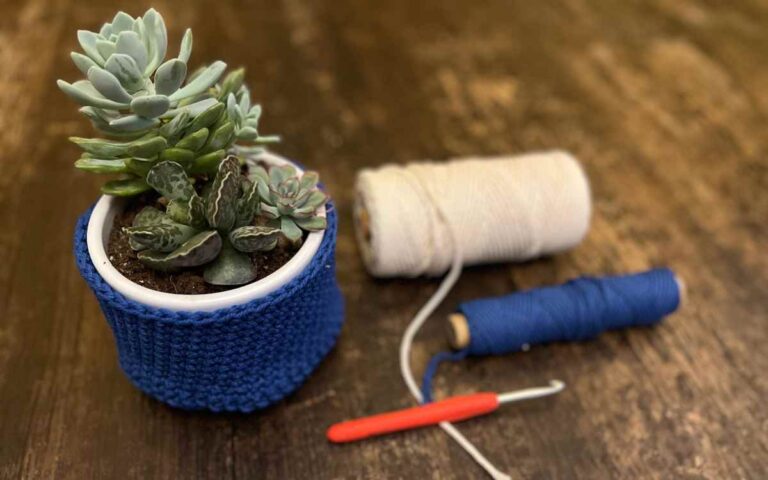Crochet Granny Square Slipper Pattern
How cute is this crochet granny square slipper pattern?! They’re constructed from just six squares each, so they’re perfect for when you fancy making a granny square project, but you haven’t got the time or the will to embark on something big like a blanket. They’ve got a cosy homespun feel which really does feel like a warm hug for your toes, so they’re a fantastic gift too – for someone you love or just for you
You can also change up the style by using a different more textured granny square for the top of the foot section, like the snowflake or 3D flower designs.
Getting the right size
Since these slippers have a soft sole, they’re a bit like socks when it comes to sizing. In other words, one size will fit several sizes of feet. If you follow this pattern exactly, the slippers will fit roughly ladies’ shoes size 6 – 9 (UK 4 – 7, EU 37 – 40). To make slippers outside of that size range, you’ll need to adapt the size of your granny squares. Don’t let that put you off though, it’s pretty straight forward to do, and I’m going to walk you through it step-by-step.
Basically, the diagonal size of your granny squares needs to be half the circumference of your foot at the widest point. Here’s a worked example of how to measure you feet and calculate the right granny square size for a perfect pair of custom made-to-measure slippers:
- Measure the circumference around the ball of your foot, right above the toes. My feet measure 9” (23cm) around this point.
- Divide that number in half. Which gives me 4½” (11.5cm). This is how big your granny squares need to be from corner to corner.
- It’s not all that intuitive to think about granny squares in terms of their diagonal size, so here’s a handy dandy online calculator for finding out how long the sides will need to be. From it I found out that the sides of my granny squares need to be approximately 3¼” (8.5cm).
My granny square pattern
Here’s the pattern I came up with to make granny squares the right size for my slippers. You can make small adjustments to the size of this pattern by making the 4th round in single crochet (for a smaller square) or double crochet (for a larger square). Or you can come up with your own design for a granny square the right size, and meet me again at the assembly stage!
Remember, you’ll need 12 squares in total – 6 per slipper. I used aran weight yarns in pink, off-white, gray marl, and brown. Rather than using the size H-8 (5mm) hook suggested by the wrapper, I opted for a size G-6 (4.5mm) hook. Your slippers will hold their shape better if the tension is sturdy – since I tend to crochet on the loose side I’ve sized down to
Round 1
Start however you like to start your granny squares – with a magic circle, or with four chain stitches joined in a loop with a slip stitch.
- Ch 3, dc 7, sl st into top of ch 3 to join.
Cut your yarn and weave in the ends.
Round 2
Join your next yarn color. This round consists of 8 cluster stitches of four double crochets, and the first one is worked a little bit differently to the rest.
For the first stitch:
- Ch 3 – this creates the height you need to complete the round, and also counts as the first double crochet in the cluster.
- Yarn over hook.
- Insert hook into the same space you made the slip stitch join into.
- Yarn over and pull through a loop (3 loops on hook).
- Yarn over and draw through two loops (2 loops on hook).
- Repeat steps 2 – 5 twice more (4 loops on hook – below left).
- Yarn over and draw through all four loops (below center).
- Ch 2 (below right).
For the rest of the stitches:
- Yarn over hook.
- Insert hook into the next space from round 1.
- Yarn over and pull through a loop (3 loops on hook).
- Yarn over and draw through two loops (2 loops on hook).
- Repeat steps 1 – 4 three times (5 loops on hook – below left).
- Yarn over and draw through all five loops (below center).
- Chain 2 (below right).
Round 3
Join your next color of yarn into any of the chain spaces between the cluster stitches from round 2.
- Into the same chain space, ch 5 (counts as 1 double crochet and 2 corner chains), dc 3.
- Dc 3 into the next chain space.
- (Dc 3, ch 2, dc 3) into the next chain space.
- Repeat steps 2 and 3 twice more.
- Dc 3 into the next chain space.
- Dc into the same space you started in, and join with a slip stitch into the 4th chain from step 1.
Cut the yarn and weave in the ends.
Round 4
Join your fourth yarn shade into any of the corner spaces from round 3.
- Into the same chain space, ch 4 (counts as 1 half-double crochet and 2 corner chains), hdc 2.
- Skip the first stitch on the next side*, and hdc into all the remaining stitches.
- (Hdc 2, ch 2, hdc 2) into the corner space.
- Repeat steps 2 and 3 twice more.
- Skip the first stitch on the next side*, and hdc into all the remaining stitches.
- Hdc once into the corner space where you started, and join the round with a slip stitch into the 3rd chain from step 1.
* Only if you’re using half-double crochet for this round. If you’re using single or double crochet to modify the size of your square, work into every stitch of each side.
Cut your yarn, weave in the ends, and block your square. Make 11 more squares.
Crochet granny square slipper pattern: assembling stage
Squares made, it’s time to think about how you’re going to join them together. Here’s an illustration of how the squares are going to be pieced together:
I’ve labeled the corresponding sides, so 1a joins to 1a, and so on. Joins 1a and 1b can be made one after the other with without cutting the yarn in between. Joins 2a – 2d can also be made in one go, and likewise joins 3a – 3d.
I joined my granny squares mine using single crochet stitches – hold the squares right sides together, and insert the hook through the front and back loops of both squares. It’s a chunky join, which I love because it makes an aesthetic nod to moccasins. But I can feel the seams under my feet a bit, an if the thought of that puts you off, you could join your squares with a flat mattress stitch or whip stitch instead.
- The final edge between corner B and the arrow head joins to the edge marked by the star – make sure the wrong sides of your squares are facing each other!
- Treat corner B the same as corner A – make two stitches in the corner space of the heel square, one for each of the other squares.
- Start at the top corner that’s going to sit above the arch of the foot, and work along the first edge (I prefer to move clockwise, but it’s not important).
- In the next corner space make two stitches – one into the square that folds around the the side of the foot, and one into the square at the front of the sole.
- In the corner which forms the toe point, make three stitches into the corner space.
- And in the last corner space make two stitches – one into the square at the front of the sole and one into the square that folds around the the side of the foot.
When you get back to the corner you started in, don’t cut the yarn – you can dive straight into making the edging around the opening with it.
Adding a picot edging
This slipper is really starting to come together! Let’s add a picot edging around the opening, to give that edge a more polished look and tie it in with the seams. The edge is made in two rows, in a counter-clockwise direction. The direction is important to ensure to the little picot bobbles pop outwards, not inwards!
- The first row is straight forward single crochet all the way round the edge.
- The second row is a simple picot border based on a two-stitch repeat: sl st, dc. The short slip stitches push the tall double crochets outwards, making an attractive bobble edge.
Finish row two on a slip stitch, cut the yarn, and weave in all the ends from joining your squares.
Pompoms
The finishing touch on my slippers are some cute little pompoms. Not only do they look the part, they’re perfect for hiding the seam joins on the front of your slipper. Also if you’ve never made little pompoms on a fork before, prepare to discover a new crafting addiction!
- Cut a 4” piece of yarn and hold it between the second and third tines of a fork (top left above).
- Wrap yarn from the ball 20 – 30 times around all four tines.
- Cut the yarn, and use the 4” piece to make an overhand knot around the center of your pom pom (top right above).
- Poke the ends through to the other side of the fork, and tie two or three more knots to fully secure the center of the pompom (bottom left above).
- Slip the pompom off the fork and carefully cut all the loops so your pompom opens out. Trim it into shape, and repeat the steps to make a second.
- Make a chain of 12 stitches, and ties your pompoms to the ends (bottom right above).
Finally, use a short length of yarn to tie your pompoms to the front of your slipper.
Now make another one!
Repeat the whole process to make a second slipper, and then put them on and wear them with pride! Or in my case, notice them sneaking out of the room on the feet of my daughter. Luckily this quick and fun pattern is easy to make again and again! I hope you enjoy making it too.
